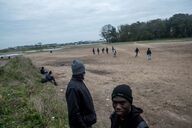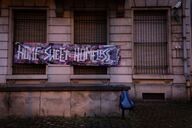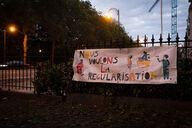Refine search
No keyword found to refine search
keywords EN
Places
Names
628 documents found
| 1 | 11 |
Documents per page :

Conference of the European Ombudsman Network on Migration
Nicolas Landemard / Le Pictorium
LePictorium_0286349.jpg
A packed room at the European Parliament in the Belgian capital today hosted a conference on human rights, migration and artificial intelligence. Speakers included Sally Hayden, journalist and writer, Emily O'reilly, representative of the European Ombudswomen, and Monique Pariat, Director General of the Commission's DG Migration and European Affairs.

Conference of the European Ombudsman Network on Migration
Nicolas Landemard / Le Pictorium
LePictorium_0286350.jpg
A packed room at the European Parliament in the Belgian capital today hosted a conference on human rights, migration and artificial intelligence. Speakers included Sally Hayden, journalist and writer, Emily O'reilly, representative of the European Ombudswomen, and Monique Pariat, Director General of the Commission's DG Migration and European Affairs.

Conference of the European Ombudsman Network on Migration
Nicolas Landemard / Le Pictorium
LePictorium_0286351.jpg
Honor Mahony. A packed room at the European Parliament in the Belgian capital today hosted a conference on human rights, migration and artificial intelligence. Speakers included Sally Hayden, journalist and writer, Emily O'reilly, representative of the European Ombudswomen, and Monique Pariat, Director General of the Commission's DG Migration and European Affairs.

Conference of the European Ombudsman Network on Migration
Nicolas Landemard / Le Pictorium
LePictorium_0286352.jpg
Emily O'Reilly. A packed room at the European Parliament in the Belgian capital today hosted a conference on human rights, migration and artificial intelligence. Speakers included Sally Hayden, journalist and writer, Emily O'reilly, representative of the European Ombudswomen, and Monique Pariat, Director General of the Commission's DG Migration and European Affairs.

Conference of the European Ombudsman Network on Migration
Nicolas Landemard / Le Pictorium
LePictorium_0286353.jpg
Emily O'Reilly. A packed room at the European Parliament in the Belgian capital today hosted a conference on human rights, migration and artificial intelligence. Speakers included Sally Hayden, journalist and writer, Emily O'reilly, representative of the European Ombudswomen, and Monique Pariat, Director General of the Commission's DG Migration and European Affairs.

Conference of the European Ombudsman Network on Migration
Nicolas Landemard / Le Pictorium
LePictorium_0286354.jpg
Emily O'Reilly. A packed room at the European Parliament in the Belgian capital today hosted a conference on human rights, migration and artificial intelligence. Speakers included Sally Hayden, journalist and writer, Emily O'reilly, representative of the European Ombudswomen, and Monique Pariat, Director General of the Commission's DG Migration and European Affairs.

Conference of the European Ombudsman Network on Migration
Nicolas Landemard / Le Pictorium
LePictorium_0286355.jpg
Sally Hayden. A packed room at the European Parliament in the Belgian capital today hosted a conference on human rights, migration and artificial intelligence. Speakers included Sally Hayden, journalist and writer, Emily O'reilly, representative of the European Ombudswomen, and Monique Pariat, Director General of the Commission's DG Migration and European Affairs.

Conference of the European Ombudsman Network on Migration
Nicolas Landemard / Le Pictorium
LePictorium_0286356.jpg
Sally Hayden. A packed room at the European Parliament in the Belgian capital today hosted a conference on human rights, migration and artificial intelligence. Speakers included Sally Hayden, journalist and writer, Emily O'reilly, representative of the European Ombudswomen, and Monique Pariat, Director General of the Commission's DG Migration and European Affairs.

Conference of the European Ombudsman Network on Migration
Nicolas Landemard / Le Pictorium
LePictorium_0286357.jpg
Sally Hayden. A packed room at the European Parliament in the Belgian capital today hosted a conference on human rights, migration and artificial intelligence. Speakers included Sally Hayden, journalist and writer, Emily O'reilly, representative of the European Ombudswomen, and Monique Pariat, Director General of the Commission's DG Migration and European Affairs.

Conference of the European Ombudsman Network on Migration
Nicolas Landemard / Le Pictorium
LePictorium_0286358.jpg
Sally Hayden. A packed room at the European Parliament in the Belgian capital today hosted a conference on human rights, migration and artificial intelligence. Speakers included Sally Hayden, journalist and writer, Emily O'reilly, representative of the European Ombudswomen, and Monique Pariat, Director General of the Commission's DG Migration and European Affairs.

Conference of the European Ombudsman Network on Migration
Nicolas Landemard / Le Pictorium
LePictorium_0286359.jpg
Sally Hayden. A packed room at the European Parliament in the Belgian capital today hosted a conference on human rights, migration and artificial intelligence. Speakers included Sally Hayden, journalist and writer, Emily O'reilly, representative of the European Ombudswomen, and Monique Pariat, Director General of the Commission's DG Migration and European Affairs.

Conference of the European Ombudsman Network on Migration
Nicolas Landemard / Le Pictorium
LePictorium_0286360.jpg
Sally Hayden. A packed room at the European Parliament in the Belgian capital today hosted a conference on human rights, migration and artificial intelligence. Speakers included Sally Hayden, journalist and writer, Emily O'reilly, representative of the European Ombudswomen, and Monique Pariat, Director General of the Commission's DG Migration and European Affairs.

Conference of the European Ombudsman Network on Migration
Nicolas Landemard / Le Pictorium
LePictorium_0286361.jpg
Sally Hayden. A packed room at the European Parliament in the Belgian capital today hosted a conference on human rights, migration and artificial intelligence. Speakers included Sally Hayden, journalist and writer, Emily O'reilly, representative of the European Ombudswomen, and Monique Pariat, Director General of the Commission's DG Migration and European Affairs.

Conference of the European Ombudsman Network on Migration
Nicolas Landemard / Le Pictorium
LePictorium_0286362.jpg
Sally Hayden. A packed room at the European Parliament in the Belgian capital today hosted a conference on human rights, migration and artificial intelligence. Speakers included Sally Hayden, journalist and writer, Emily O'reilly, representative of the European Ombudswomen, and Monique Pariat, Director General of the Commission's DG Migration and European Affairs.

Conference of the European Ombudsman Network on Migration
Nicolas Landemard / Le Pictorium
LePictorium_0286363.jpg
Emily O'Reilly. A packed room at the European Parliament in the Belgian capital today hosted a conference on human rights, migration and artificial intelligence. Speakers included Sally Hayden, journalist and writer, Emily O'reilly, representative of the European Ombudswomen, and Monique Pariat, Director General of the Commission's DG Migration and European Affairs.

Conference of the European Ombudsman Network on Migration
Nicolas Landemard / Le Pictorium
LePictorium_0286364.jpg
Monique Pariat. A packed room at the European Parliament in the Belgian capital today hosted a conference on human rights, migration and artificial intelligence. Speakers included Sally Hayden, journalist and writer, Emily O'reilly, representative of the European Ombudswomen, and Monique Pariat, Director General of the Commission's DG Migration and European Affairs.

Conference of the European Ombudsman Network on Migration
Nicolas Landemard / Le Pictorium
LePictorium_0286365.jpg
Monique Pariat. A packed room at the European Parliament in the Belgian capital today hosted a conference on human rights, migration and artificial intelligence. Speakers included Sally Hayden, journalist and writer, Emily O'reilly, representative of the European Ombudswomen, and Monique Pariat, Director General of the Commission's DG Migration and European Affairs.

Conference of the European Ombudsman Network on Migration
Nicolas Landemard / Le Pictorium
LePictorium_0286366.jpg
Monique Pariat. A packed room at the European Parliament in the Belgian capital today hosted a conference on human rights, migration and artificial intelligence. Speakers included Sally Hayden, journalist and writer, Emily O'reilly, representative of the European Ombudswomen, and Monique Pariat, Director General of the Commission's DG Migration and European Affairs.

November 2016, Evacuation of the Calais "Jungle
Michael Bunel / Le Pictorium
LePictorium_0286323.jpg
Forces de l'ordre cordon off camp accesses as refugees await evacuation. Buses chartered by the prefecture are due to take the exiles to reception centers. According to the associations on site (HRO and Utopia 56), people had two choices: get on the bus or have to deal with the PAF (border police). November 16, 2021. Grande Synthe.
November 2016, the "jungle" of Calais, the largest shantytown in Europe, was evacuated. Five years later, the exiles on the road to Great Britain are still there and camps are regularly created between Calais and Grande-Synthe. The only new thing is that the police dismantle them every two to three days to avoid the creation of a new "jungle". A tried and tested method, despite the health crisis, which "works" in the eyes of the authorities, who again expelled hundreds of migrants from Grande-Synthe on Tuesday. But it does not make the exiles disappear. Five years after the "jungle", the situation has not changed so much. On the contrary, living conditions have further deteriorated and the generalization of passages and the ensuing dramas have multiplied. The state of affairs is appalling. The dialogue between the associations and the prefecture does not find its way, while the exiles are relentlessly chased, wherever they are. A precarious situation that does not facilitate the collection of testimonies, so great is the suspicion among the candidates for exile.
November 2016, the "jungle" of Calais, the largest shantytown in Europe, was evacuated. Five years later, the exiles on the road to Great Britain are still there and camps are regularly created between Calais and Grande-Synthe. The only new thing is that the police dismantle them every two to three days to avoid the creation of a new "jungle". A tried and tested method, despite the health crisis, which "works" in the eyes of the authorities, who again expelled hundreds of migrants from Grande-Synthe on Tuesday. But it does not make the exiles disappear. Five years after the "jungle", the situation has not changed so much. On the contrary, living conditions have further deteriorated and the generalization of passages and the ensuing dramas have multiplied. The state of affairs is appalling. The dialogue between the associations and the prefecture does not find its way, while the exiles are relentlessly chased, wherever they are. A precarious situation that does not facilitate the collection of testimonies, so great is the suspicion among the candidates for exile.

November 2016, Evacuation of the Calais "Jungle
Michael Bunel / Le Pictorium
LePictorium_0286324.jpg
Sudanese refugees are playing soccer on the moor, where they have set up several tents between evictions. Since then, stones have been installed to prevent access to the moor. Associations can no longer access the area to distribute food or fill water tanks.
November 2016, the "jungle" of Calais, the largest shantytown in Europe, was evacuated. Five years later, the exiles on the road to Great Britain are still there and camps are regularly created between Calais and Grande-Synthe. The only new thing is that the police dismantle them every two to three days to avoid the creation of a new "jungle". A tried and tested method, despite the health crisis, which "works" in the eyes of the authorities, who again expelled hundreds of migrants from Grande-Synthe on Tuesday. But it does not make the exiles disappear. Five years after the "jungle", the situation has not changed so much. On the contrary, living conditions have further deteriorated and the generalization of passages and the ensuing dramas have multiplied. The state of affairs is appalling. The dialogue between the associations and the prefecture does not find its way, while the exiles are relentlessly chased, wherever they are. A precarious situation that does not facilitate the collection of testimonies, so great is the suspicion among the candidates for exile.
November 2016, the "jungle" of Calais, the largest shantytown in Europe, was evacuated. Five years later, the exiles on the road to Great Britain are still there and camps are regularly created between Calais and Grande-Synthe. The only new thing is that the police dismantle them every two to three days to avoid the creation of a new "jungle". A tried and tested method, despite the health crisis, which "works" in the eyes of the authorities, who again expelled hundreds of migrants from Grande-Synthe on Tuesday. But it does not make the exiles disappear. Five years after the "jungle", the situation has not changed so much. On the contrary, living conditions have further deteriorated and the generalization of passages and the ensuing dramas have multiplied. The state of affairs is appalling. The dialogue between the associations and the prefecture does not find its way, while the exiles are relentlessly chased, wherever they are. A precarious situation that does not facilitate the collection of testimonies, so great is the suspicion among the candidates for exile.

November 2016, Evacuation of the Calais "Jungle
Michael Bunel / Le Pictorium
LePictorium_0286325.jpg
A 14-year-old unaccompanied minor from Eritrea hides in the bushes in the hope of boarding a truck to Great Britain. This system of passage is favored by people who logically cannot afford a smuggler. November 11, 2021. Calais.
November 2016, the "jungle" of Calais, the largest shantytown in Europe, was evacuated. Five years later, the exiles on the road to Great Britain are still there and camps are regularly created between Calais and Grande-Synthe. The only new thing is that the police dismantle them every two to three days to avoid the creation of a new "jungle". A tried and tested method, despite the health crisis, which "works" in the eyes of the authorities, who again expelled hundreds of migrants from Grande-Synthe on Tuesday. But it does not make the exiles disappear. Five years after the "jungle", the situation has not changed so much. On the contrary, living conditions have further deteriorated and the generalization of passages and the ensuing dramas have multiplied. The state of affairs is appalling. The dialogue between the associations and the prefecture does not find its way, while the exiles are relentlessly chased, wherever they are. A precarious situation that does not facilitate the collection of testimonies, so great is the suspicion among the candidates for exile.
November 2016, the "jungle" of Calais, the largest shantytown in Europe, was evacuated. Five years later, the exiles on the road to Great Britain are still there and camps are regularly created between Calais and Grande-Synthe. The only new thing is that the police dismantle them every two to three days to avoid the creation of a new "jungle". A tried and tested method, despite the health crisis, which "works" in the eyes of the authorities, who again expelled hundreds of migrants from Grande-Synthe on Tuesday. But it does not make the exiles disappear. Five years after the "jungle", the situation has not changed so much. On the contrary, living conditions have further deteriorated and the generalization of passages and the ensuing dramas have multiplied. The state of affairs is appalling. The dialogue between the associations and the prefecture does not find its way, while the exiles are relentlessly chased, wherever they are. A precarious situation that does not facilitate the collection of testimonies, so great is the suspicion among the candidates for exile.

November 2016, Evacuation of the Calais "Jungle
Michael Bunel / Le Pictorium
LePictorium_0286326.jpg
One of the three encampments in Calais today, grouping around a hundred people. Some tents are set up near the railway line, others in the woods. The police carry out evictions every two or three days, destroying material.
November 2016, the "jungle" of Calais, the largest shantytown in Europe, was evacuated. Five years later, the exiles on the road to Great Britain are still there and camps are regularly created between Calais and Grande-Synthe. The only new thing is that the police dismantle them every two to three days to avoid the creation of a new "jungle". A tried and tested method, despite the health crisis, which "works" in the eyes of the authorities, who again expelled hundreds of migrants from Grande-Synthe on Tuesday. But it does not make the exiles disappear. Five years after the "jungle", the situation has not changed so much. On the contrary, living conditions have further deteriorated and the generalization of passages and the ensuing dramas have multiplied. The state of affairs is appalling. The dialogue between the associations and the prefecture does not find its way, while the exiles are relentlessly chased, wherever they are. A precarious situation that does not facilitate the collection of testimonies, so great is the suspicion among the candidates for exile.
November 2016, the "jungle" of Calais, the largest shantytown in Europe, was evacuated. Five years later, the exiles on the road to Great Britain are still there and camps are regularly created between Calais and Grande-Synthe. The only new thing is that the police dismantle them every two to three days to avoid the creation of a new "jungle". A tried and tested method, despite the health crisis, which "works" in the eyes of the authorities, who again expelled hundreds of migrants from Grande-Synthe on Tuesday. But it does not make the exiles disappear. Five years after the "jungle", the situation has not changed so much. On the contrary, living conditions have further deteriorated and the generalization of passages and the ensuing dramas have multiplied. The state of affairs is appalling. The dialogue between the associations and the prefecture does not find its way, while the exiles are relentlessly chased, wherever they are. A precarious situation that does not facilitate the collection of testimonies, so great is the suspicion among the candidates for exile.

November 2016, Evacuation of the Calais "Jungle
Michael Bunel / Le Pictorium
LePictorium_0286327.jpg
One of the three encampments in Calais today, grouping around a hundred people. Some tents are set up near the railway line, others in the woods. The police carry out evictions every two or three days, destroying material.
November 2016, the "jungle" of Calais, the largest shantytown in Europe, was evacuated. Five years later, the exiles on the road to Great Britain are still there and camps are regularly created between Calais and Grande-Synthe. The only new thing is that the police dismantle them every two to three days to avoid the creation of a new "jungle". A tried and tested method, despite the health crisis, which "works" in the eyes of the authorities, who again expelled hundreds of migrants from Grande-Synthe on Tuesday. But it does not make the exiles disappear. Five years after the "jungle", the situation has not changed so much. On the contrary, living conditions have further deteriorated and the generalization of passages and the ensuing dramas have multiplied. The state of affairs is appalling. The dialogue between the associations and the prefecture does not find its way, while the exiles are relentlessly chased, wherever they are. A precarious situation that does not facilitate the collection of testimonies, so great is the suspicion among the candidates for exile.
November 2016, the "jungle" of Calais, the largest shantytown in Europe, was evacuated. Five years later, the exiles on the road to Great Britain are still there and camps are regularly created between Calais and Grande-Synthe. The only new thing is that the police dismantle them every two to three days to avoid the creation of a new "jungle". A tried and tested method, despite the health crisis, which "works" in the eyes of the authorities, who again expelled hundreds of migrants from Grande-Synthe on Tuesday. But it does not make the exiles disappear. Five years after the "jungle", the situation has not changed so much. On the contrary, living conditions have further deteriorated and the generalization of passages and the ensuing dramas have multiplied. The state of affairs is appalling. The dialogue between the associations and the prefecture does not find its way, while the exiles are relentlessly chased, wherever they are. A precarious situation that does not facilitate the collection of testimonies, so great is the suspicion among the candidates for exile.

November 2016, Evacuation of the Calais "Jungle
Michael Bunel / Le Pictorium
LePictorium_0286328.jpg
Around a hundred tents are set up in a disused hangar. More than 1,000 people, mostly of Kurdish origin, are crammed into this insalubrious camp. The camp is located opposite the Auchan shopping center. November 13, 2021. Grande Synthe, France.
November 2016, the "jungle" of Calais, the largest shantytown in Europe, was evacuated. Five years later, the exiles on the road to Great Britain are still there and camps are regularly created between Calais and Grande-Synthe. The only new thing is that the police dismantle them every two to three days to avoid the creation of a new "jungle". A tried and tested method, despite the health crisis, which "works" in the eyes of the authorities, who again expelled hundreds of migrants from Grande-Synthe on Tuesday. But it does not make the exiles disappear. Five years after the "jungle", the situation has not changed so much. On the contrary, living conditions have further deteriorated and the generalization of passages and the ensuing dramas have multiplied. The state of affairs is appalling. The dialogue between the associations and the prefecture does not find its way, while the exiles are relentlessly chased, wherever they are. A precarious situation that does not facilitate the collection of testimonies, so great is the suspicion among the candidates for exile.
November 2016, the "jungle" of Calais, the largest shantytown in Europe, was evacuated. Five years later, the exiles on the road to Great Britain are still there and camps are regularly created between Calais and Grande-Synthe. The only new thing is that the police dismantle them every two to three days to avoid the creation of a new "jungle". A tried and tested method, despite the health crisis, which "works" in the eyes of the authorities, who again expelled hundreds of migrants from Grande-Synthe on Tuesday. But it does not make the exiles disappear. Five years after the "jungle", the situation has not changed so much. On the contrary, living conditions have further deteriorated and the generalization of passages and the ensuing dramas have multiplied. The state of affairs is appalling. The dialogue between the associations and the prefecture does not find its way, while the exiles are relentlessly chased, wherever they are. A precarious situation that does not facilitate the collection of testimonies, so great is the suspicion among the candidates for exile.

November 2016, Evacuation of the Calais "Jungle
Michael Bunel / Le Pictorium
LePictorium_0286329.jpg
General view of the Grande Synthe camp. More than 1,000 people, mostly of Kurdish origin, are crammed into this insalubrious camp. The camp is located opposite the Auchan shopping center. November 13, 2021. Grande Synthe, France.
November 2016, the "jungle" of Calais, the largest shantytown in Europe, was evacuated. Five years later, the exiles on the road to Great Britain are still there and camps are regularly created between Calais and Grande-Synthe. The only new thing is that the police dismantle them every two to three days to avoid the creation of a new "jungle". A tried and tested method, despite the health crisis, which "works" in the eyes of the authorities, who again expelled hundreds of migrants from Grande-Synthe on Tuesday. But it does not make the exiles disappear. Five years after the "jungle", the situation has not changed so much. On the contrary, living conditions have further deteriorated and the generalization of passages and the ensuing dramas have multiplied. The state of affairs is appalling. The dialogue between the associations and the prefecture does not find its way, while the exiles are relentlessly chased, wherever they are. A precarious situation that does not facilitate the collection of testimonies, so great is the suspicion among the candidates for exile.
November 2016, the "jungle" of Calais, the largest shantytown in Europe, was evacuated. Five years later, the exiles on the road to Great Britain are still there and camps are regularly created between Calais and Grande-Synthe. The only new thing is that the police dismantle them every two to three days to avoid the creation of a new "jungle". A tried and tested method, despite the health crisis, which "works" in the eyes of the authorities, who again expelled hundreds of migrants from Grande-Synthe on Tuesday. But it does not make the exiles disappear. Five years after the "jungle", the situation has not changed so much. On the contrary, living conditions have further deteriorated and the generalization of passages and the ensuing dramas have multiplied. The state of affairs is appalling. The dialogue between the associations and the prefecture does not find its way, while the exiles are relentlessly chased, wherever they are. A precarious situation that does not facilitate the collection of testimonies, so great is the suspicion among the candidates for exile.

November 2016, Evacuation of the Calais "Jungle
Michael Bunel / Le Pictorium
LePictorium_0286330.jpg
General view of the Grande Synthe camp. More than 1,000 people, mostly of Kurdish origin, are crammed into this insalubrious camp. The camp is located opposite the Auchan shopping center. November 13, 2021. Grande Synthe, France.
November 2016, the "jungle" of Calais, the largest shantytown in Europe, was evacuated. Five years later, the exiles on the road to Great Britain are still there and camps are regularly created between Calais and Grande-Synthe. The only new thing is that the police dismantle them every two to three days to avoid the creation of a new "jungle". A tried and tested method, despite the health crisis, which "works" in the eyes of the authorities, who again expelled hundreds of migrants from Grande-Synthe on Tuesday. But it does not make the exiles disappear. Five years after the "jungle", the situation has not changed so much. On the contrary, living conditions have further deteriorated and the generalization of passages and the ensuing dramas have multiplied. The state of affairs is appalling. The dialogue between the associations and the prefecture does not find its way, while the exiles are relentlessly chased, wherever they are. A precarious situation that does not facilitate the collection of testimonies, so great is the suspicion among the candidates for exile.
November 2016, the "jungle" of Calais, the largest shantytown in Europe, was evacuated. Five years later, the exiles on the road to Great Britain are still there and camps are regularly created between Calais and Grande-Synthe. The only new thing is that the police dismantle them every two to three days to avoid the creation of a new "jungle". A tried and tested method, despite the health crisis, which "works" in the eyes of the authorities, who again expelled hundreds of migrants from Grande-Synthe on Tuesday. But it does not make the exiles disappear. Five years after the "jungle", the situation has not changed so much. On the contrary, living conditions have further deteriorated and the generalization of passages and the ensuing dramas have multiplied. The state of affairs is appalling. The dialogue between the associations and the prefecture does not find its way, while the exiles are relentlessly chased, wherever they are. A precarious situation that does not facilitate the collection of testimonies, so great is the suspicion among the candidates for exile.

November 2016, Evacuation of the Calais "Jungle
Michael Bunel / Le Pictorium
LePictorium_0286331.jpg
The Slack dunes near Wimereux. According to the Préfecture Maritime 12,000 attempts were made between January and July 2021 last year. This compares with 2,294 attempts in 2019. November 17, 2021. Wimereux.
November 2016, the "jungle" of Calais, the largest shantytown in Europe, was evacuated. Five years later, the exiles on the road to Great Britain are still there and camps are regularly created between Calais and Grande-Synthe. The only new thing is that the police dismantle them every two to three days to avoid the creation of a new "jungle". A tried and tested method, despite the health crisis, which "works" in the eyes of the authorities, who again expelled hundreds of migrants from Grande-Synthe on Tuesday. But it does not make the exiles disappear. Five years after the "jungle", the situation has not changed so much. On the contrary, living conditions have further deteriorated and the generalization of passages and the ensuing dramas have multiplied. The state of affairs is appalling. The dialogue between the associations and the prefecture does not find its way, while the exiles are relentlessly chased, wherever they are. A precarious situation that does not facilitate the collection of testimonies, so great is the suspicion among the candidates for exile.
November 2016, the "jungle" of Calais, the largest shantytown in Europe, was evacuated. Five years later, the exiles on the road to Great Britain are still there and camps are regularly created between Calais and Grande-Synthe. The only new thing is that the police dismantle them every two to three days to avoid the creation of a new "jungle". A tried and tested method, despite the health crisis, which "works" in the eyes of the authorities, who again expelled hundreds of migrants from Grande-Synthe on Tuesday. But it does not make the exiles disappear. Five years after the "jungle", the situation has not changed so much. On the contrary, living conditions have further deteriorated and the generalization of passages and the ensuing dramas have multiplied. The state of affairs is appalling. The dialogue between the associations and the prefecture does not find its way, while the exiles are relentlessly chased, wherever they are. A precarious situation that does not facilitate the collection of testimonies, so great is the suspicion among the candidates for exile.

November 2016, Evacuation of the Calais "Jungle
Michael Bunel / Le Pictorium
LePictorium_0286332.jpg
Muslim cemetery in the north of Calais. Tomb of Yasser Abdallah, a 20-year-old Sudanese, who died on the night of Tuesday September 28, mowed down by a truck..
November 2016, the "jungle" of Calais, the largest shantytown in Europe, was evacuated. Five years later, the exiles on the road to Great Britain are still there and camps are regularly created between Calais and Grande-Synthe. The only new thing is that the police dismantle them every two to three days to avoid the creation of a new "jungle". A tried and tested method, despite the health crisis, which "works" in the eyes of the authorities, who again expelled hundreds of migrants from Grande-Synthe on Tuesday. But it does not make the exiles disappear. Five years after the "jungle", the situation has not changed so much. On the contrary, living conditions have further deteriorated and the generalization of passages and the ensuing dramas have multiplied. The state of affairs is appalling. The dialogue between the associations and the prefecture does not find its way, while the exiles are relentlessly chased, wherever they are. A precarious situation that does not facilitate the collection of testimonies, so great is the suspicion among the candidates for exile.
November 2016, the "jungle" of Calais, the largest shantytown in Europe, was evacuated. Five years later, the exiles on the road to Great Britain are still there and camps are regularly created between Calais and Grande-Synthe. The only new thing is that the police dismantle them every two to three days to avoid the creation of a new "jungle". A tried and tested method, despite the health crisis, which "works" in the eyes of the authorities, who again expelled hundreds of migrants from Grande-Synthe on Tuesday. But it does not make the exiles disappear. Five years after the "jungle", the situation has not changed so much. On the contrary, living conditions have further deteriorated and the generalization of passages and the ensuing dramas have multiplied. The state of affairs is appalling. The dialogue between the associations and the prefecture does not find its way, while the exiles are relentlessly chased, wherever they are. A precarious situation that does not facilitate the collection of testimonies, so great is the suspicion among the candidates for exile.

November 2016, Evacuation of the Calais "Jungle
Michael Bunel / Le Pictorium
LePictorium_0286333.jpg
Men talking to each other as the evacuation of the camp begins. A camp of over 1,000 people, mostly Kurds and Iraqis, had taken up residence in the shopping area of the Auchan store in Grande Synthe. The prefecture ordered the dismantling of the camp this morning. The exiles were not notified in accordance with the government's undertakings. November 16, 2021. Grande Synthe. France.
November 2016, the "jungle" of Calais, the largest shantytown in Europe, was evacuated. Five years later, the exiles on the road to Great Britain are still there and camps are regularly created between Calais and Grande-Synthe. The only new thing is that the police dismantle them every two to three days to avoid the creation of a new "jungle". A tried and tested method, despite the health crisis, which "works" in the eyes of the authorities, who again expelled hundreds of migrants from Grande-Synthe on Tuesday. But it does not make the exiles disappear. Five years after the "jungle", the situation has not changed so much. On the contrary, living conditions have further deteriorated and the generalization of passages and the ensuing dramas have multiplied. The state of affairs is appalling. The dialogue between the associations and the prefecture does not find its way, while the exiles are relentlessly chased, wherever they are. A precarious situation that does not facilitate the collection of testimonies, so great is the suspicion among the candidates for exile.
November 2016, the "jungle" of Calais, the largest shantytown in Europe, was evacuated. Five years later, the exiles on the road to Great Britain are still there and camps are regularly created between Calais and Grande-Synthe. The only new thing is that the police dismantle them every two to three days to avoid the creation of a new "jungle". A tried and tested method, despite the health crisis, which "works" in the eyes of the authorities, who again expelled hundreds of migrants from Grande-Synthe on Tuesday. But it does not make the exiles disappear. Five years after the "jungle", the situation has not changed so much. On the contrary, living conditions have further deteriorated and the generalization of passages and the ensuing dramas have multiplied. The state of affairs is appalling. The dialogue between the associations and the prefecture does not find its way, while the exiles are relentlessly chased, wherever they are. A precarious situation that does not facilitate the collection of testimonies, so great is the suspicion among the candidates for exile.

November 2016, Evacuation of the Calais "Jungle
Michael Bunel / Le Pictorium
LePictorium_0286334.jpg
The Dunkirk camp is cordoned off by the forces of law and order. Journalists on site this morning announced to the refugees that the camp was to be dismantled. The prefecture had promised to inform the exiles and associations 48 hours in advance. November 16, 2021. Grande Synthe.
November 2016, the "jungle" of Calais, the largest shantytown in Europe, was evacuated. Five years later, the exiles on the road to Great Britain are still there and camps are regularly created between Calais and Grande-Synthe. The only new thing is that the police dismantle them every two to three days to avoid the creation of a new "jungle". A tried and tested method, despite the health crisis, which "works" in the eyes of the authorities, who again expelled hundreds of migrants from Grande-Synthe on Tuesday. But it does not make the exiles disappear. Five years after the "jungle", the situation has not changed so much. On the contrary, living conditions have further deteriorated and the generalization of passages and the ensuing dramas have multiplied. The state of affairs is appalling. The dialogue between the associations and the prefecture does not find its way, while the exiles are relentlessly chased, wherever they are. A precarious situation that does not facilitate the collection of testimonies, so great is the suspicion among the candidates for exile.
November 2016, the "jungle" of Calais, the largest shantytown in Europe, was evacuated. Five years later, the exiles on the road to Great Britain are still there and camps are regularly created between Calais and Grande-Synthe. The only new thing is that the police dismantle them every two to three days to avoid the creation of a new "jungle". A tried and tested method, despite the health crisis, which "works" in the eyes of the authorities, who again expelled hundreds of migrants from Grande-Synthe on Tuesday. But it does not make the exiles disappear. Five years after the "jungle", the situation has not changed so much. On the contrary, living conditions have further deteriorated and the generalization of passages and the ensuing dramas have multiplied. The state of affairs is appalling. The dialogue between the associations and the prefecture does not find its way, while the exiles are relentlessly chased, wherever they are. A precarious situation that does not facilitate the collection of testimonies, so great is the suspicion among the candidates for exile.

November 2016, Evacuation of the Calais "Jungle
Michael Bunel / Le Pictorium
LePictorium_0286335.jpg
Two men smoke a cigarette during the evacuation of the camp. A camp of over 1,000 people, mostly Kurds and Iraqis, had taken up residence in the shopping area of the Auchan store in Grande Synthe. The prefecture ordered the dismantling of the camp this morning. The exiles were not notified in accordance with the government's undertakings. November 16, 2021. Grande Synthe. France.
November 2016, the "jungle" of Calais, the largest shantytown in Europe, was evacuated. Five years later, the exiles on the road to Great Britain are still there and camps are regularly created between Calais and Grande-Synthe. The only new thing is that the police dismantle them every two to three days to avoid the creation of a new "jungle". A tried and tested method, despite the health crisis, which "works" in the eyes of the authorities, who again expelled hundreds of migrants from Grande-Synthe on Tuesday. But it does not make the exiles disappear. Five years after the "jungle", the situation has not changed so much. On the contrary, living conditions have further deteriorated and the generalization of passages and the ensuing dramas have multiplied. The state of affairs is appalling. The dialogue between the associations and the prefecture does not find its way, while the exiles are relentlessly chased, wherever they are. A precarious situation that does not facilitate the collection of testimonies, so great is the suspicion among the candidates for exile.
November 2016, the "jungle" of Calais, the largest shantytown in Europe, was evacuated. Five years later, the exiles on the road to Great Britain are still there and camps are regularly created between Calais and Grande-Synthe. The only new thing is that the police dismantle them every two to three days to avoid the creation of a new "jungle". A tried and tested method, despite the health crisis, which "works" in the eyes of the authorities, who again expelled hundreds of migrants from Grande-Synthe on Tuesday. But it does not make the exiles disappear. Five years after the "jungle", the situation has not changed so much. On the contrary, living conditions have further deteriorated and the generalization of passages and the ensuing dramas have multiplied. The state of affairs is appalling. The dialogue between the associations and the prefecture does not find its way, while the exiles are relentlessly chased, wherever they are. A precarious situation that does not facilitate the collection of testimonies, so great is the suspicion among the candidates for exile.

November 2016, Evacuation of the Calais "Jungle
Michael Bunel / Le Pictorium
LePictorium_0286336.jpg
A family chats around a fire while waiting for the camp to be evacuated by the police. Journalists on the scene this morning announced to the refugees that the camp was to be dismantled. The prefecture had promised to inform the exiles and associations 48 hours in advance. November 16, 2021. Grande Synthe.
November 2016, the "jungle" of Calais, the largest shantytown in Europe, was evacuated. Five years later, the exiles on the road to Great Britain are still there and camps are regularly created between Calais and Grande-Synthe. The only new thing is that the police dismantle them every two to three days to avoid the creation of a new "jungle". A tried and tested method, despite the health crisis, which "works" in the eyes of the authorities, who again expelled hundreds of migrants from Grande-Synthe on Tuesday. But it does not make the exiles disappear. Five years after the "jungle", the situation has not changed so much. On the contrary, living conditions have further deteriorated and the generalization of passages and the ensuing dramas have multiplied. The state of affairs is appalling. The dialogue between the associations and the prefecture does not find its way, while the exiles are relentlessly chased, wherever they are. A precarious situation that does not facilitate the collection of testimonies, so great is the suspicion among the candidates for exile.
November 2016, the "jungle" of Calais, the largest shantytown in Europe, was evacuated. Five years later, the exiles on the road to Great Britain are still there and camps are regularly created between Calais and Grande-Synthe. The only new thing is that the police dismantle them every two to three days to avoid the creation of a new "jungle". A tried and tested method, despite the health crisis, which "works" in the eyes of the authorities, who again expelled hundreds of migrants from Grande-Synthe on Tuesday. But it does not make the exiles disappear. Five years after the "jungle", the situation has not changed so much. On the contrary, living conditions have further deteriorated and the generalization of passages and the ensuing dramas have multiplied. The state of affairs is appalling. The dialogue between the associations and the prefecture does not find its way, while the exiles are relentlessly chased, wherever they are. A precarious situation that does not facilitate the collection of testimonies, so great is the suspicion among the candidates for exile.

November 2016, Evacuation of the Calais "Jungle
Michael Bunel / Le Pictorium
LePictorium_0286337.jpg
During the dismantling of the Grande Synthe exile camp, a cleaning team uses a knife to slash exiles' tents in full view of the police. A method denounced by associations for several months. November 16, 2021. Grande Synthe.
November 2016, the "jungle" of Calais, the largest shantytown in Europe, was evacuated. Five years later, the exiles on the road to Great Britain are still there and camps are regularly created between Calais and Grande-Synthe. The only new thing is that the police dismantle them every two to three days to avoid the creation of a new "jungle". A tried and tested method, despite the health crisis, which "works" in the eyes of the authorities, who again expelled hundreds of migrants from Grande-Synthe on Tuesday. But it does not make the exiles disappear. Five years after the "jungle", the situation has not changed so much. On the contrary, living conditions have further deteriorated and the generalization of passages and the ensuing dramas have multiplied. The state of affairs is appalling. The dialogue between the associations and the prefecture does not find its way, while the exiles are relentlessly chased, wherever they are. A precarious situation that does not facilitate the collection of testimonies, so great is the suspicion among the candidates for exile.
November 2016, the "jungle" of Calais, the largest shantytown in Europe, was evacuated. Five years later, the exiles on the road to Great Britain are still there and camps are regularly created between Calais and Grande-Synthe. The only new thing is that the police dismantle them every two to three days to avoid the creation of a new "jungle". A tried and tested method, despite the health crisis, which "works" in the eyes of the authorities, who again expelled hundreds of migrants from Grande-Synthe on Tuesday. But it does not make the exiles disappear. Five years after the "jungle", the situation has not changed so much. On the contrary, living conditions have further deteriorated and the generalization of passages and the ensuing dramas have multiplied. The state of affairs is appalling. The dialogue between the associations and the prefecture does not find its way, while the exiles are relentlessly chased, wherever they are. A precarious situation that does not facilitate the collection of testimonies, so great is the suspicion among the candidates for exile.

November 2016, Evacuation of the Calais "Jungle
Michael Bunel / Le Pictorium
LePictorium_0286338.jpg
Several tents lined up side by side on a muddy floor. After the evacuation of the Grande Synthe camp on November 16, a new camp, made up mainly of Kurdish exiles, has been set up near Grande Synthe. November 29, 2021. Loon Plage. France.
November 2016, the "jungle" of Calais, the largest shantytown in Europe, was evacuated. Five years later, the exiles on the road to Great Britain are still there and camps are regularly created between Calais and Grande-Synthe. The only new thing is that the police dismantle them every two to three days to avoid the creation of a new "jungle". A tried and tested method, despite the health crisis, which "works" in the eyes of the authorities, who again expelled hundreds of migrants from Grande-Synthe on Tuesday. But it does not make the exiles disappear. Five years after the "jungle", the situation has not changed so much. On the contrary, living conditions have further deteriorated and the generalization of passages and the ensuing dramas have multiplied. The state of affairs is appalling. The dialogue between the associations and the prefecture does not find its way, while the exiles are relentlessly chased, wherever they are. A precarious situation that does not facilitate the collection of testimonies, so great is the suspicion among the candidates for exile.
November 2016, the "jungle" of Calais, the largest shantytown in Europe, was evacuated. Five years later, the exiles on the road to Great Britain are still there and camps are regularly created between Calais and Grande-Synthe. The only new thing is that the police dismantle them every two to three days to avoid the creation of a new "jungle". A tried and tested method, despite the health crisis, which "works" in the eyes of the authorities, who again expelled hundreds of migrants from Grande-Synthe on Tuesday. But it does not make the exiles disappear. Five years after the "jungle", the situation has not changed so much. On the contrary, living conditions have further deteriorated and the generalization of passages and the ensuing dramas have multiplied. The state of affairs is appalling. The dialogue between the associations and the prefecture does not find its way, while the exiles are relentlessly chased, wherever they are. A precarious situation that does not facilitate the collection of testimonies, so great is the suspicion among the candidates for exile.

November 2016, Evacuation of the Calais "Jungle
Michael Bunel / Le Pictorium
LePictorium_0286339.jpg
General view of the Dunkirk camp. Following the evacuation of the Grande Synthe camp on November 16, a new camp, mainly made up of Kurdish exiles, has been set up near Grande Synthe. November 29, 2021. Loon Plage. France.
November 2016, the "jungle" of Calais, the largest shantytown in Europe, was evacuated. Five years later, the exiles on the road to Great Britain are still there and camps are regularly created between Calais and Grande-Synthe. The only new thing is that the police dismantle them every two to three days to avoid the creation of a new "jungle". A tried and tested method, despite the health crisis, which "works" in the eyes of the authorities, who again expelled hundreds of migrants from Grande-Synthe on Tuesday. But it does not make the exiles disappear. Five years after the "jungle", the situation has not changed so much. On the contrary, living conditions have further deteriorated and the generalization of passages and the ensuing dramas have multiplied. The state of affairs is appalling. The dialogue between the associations and the prefecture does not find its way, while the exiles are relentlessly chased, wherever they are. A precarious situation that does not facilitate the collection of testimonies, so great is the suspicion among the candidates for exile.
November 2016, the "jungle" of Calais, the largest shantytown in Europe, was evacuated. Five years later, the exiles on the road to Great Britain are still there and camps are regularly created between Calais and Grande-Synthe. The only new thing is that the police dismantle them every two to three days to avoid the creation of a new "jungle". A tried and tested method, despite the health crisis, which "works" in the eyes of the authorities, who again expelled hundreds of migrants from Grande-Synthe on Tuesday. But it does not make the exiles disappear. Five years after the "jungle", the situation has not changed so much. On the contrary, living conditions have further deteriorated and the generalization of passages and the ensuing dramas have multiplied. The state of affairs is appalling. The dialogue between the associations and the prefecture does not find its way, while the exiles are relentlessly chased, wherever they are. A precarious situation that does not facilitate the collection of testimonies, so great is the suspicion among the candidates for exile.

November 2016, Evacuation of the Calais "Jungle
Michael Bunel / Le Pictorium
LePictorium_0286340.jpg
Distribution of food by the Refugee community kitchen association. Following the evacuation of the Grande Synthe camp on November 16, a new camp, mainly made up of Kurdish exiles, has been set up near Grande Synthe. November 29, 2021. Loon Plage. France.
November 2016, the "jungle" of Calais, the largest shantytown in Europe, was evacuated. Five years later, the exiles on the road to Great Britain are still there and camps are regularly created between Calais and Grande-Synthe. The only new thing is that the police dismantle them every two to three days to avoid the creation of a new "jungle". A tried and tested method, despite the health crisis, which "works" in the eyes of the authorities, who again expelled hundreds of migrants from Grande-Synthe on Tuesday. But it does not make the exiles disappear. Five years after the "jungle", the situation has not changed so much. On the contrary, living conditions have further deteriorated and the generalization of passages and the ensuing dramas have multiplied. The state of affairs is appalling. The dialogue between the associations and the prefecture does not find its way, while the exiles are relentlessly chased, wherever they are. A precarious situation that does not facilitate the collection of testimonies, so great is the suspicion among the candidates for exile.
November 2016, the "jungle" of Calais, the largest shantytown in Europe, was evacuated. Five years later, the exiles on the road to Great Britain are still there and camps are regularly created between Calais and Grande-Synthe. The only new thing is that the police dismantle them every two to three days to avoid the creation of a new "jungle". A tried and tested method, despite the health crisis, which "works" in the eyes of the authorities, who again expelled hundreds of migrants from Grande-Synthe on Tuesday. But it does not make the exiles disappear. Five years after the "jungle", the situation has not changed so much. On the contrary, living conditions have further deteriorated and the generalization of passages and the ensuing dramas have multiplied. The state of affairs is appalling. The dialogue between the associations and the prefecture does not find its way, while the exiles are relentlessly chased, wherever they are. A precarious situation that does not facilitate the collection of testimonies, so great is the suspicion among the candidates for exile.

November 2016, Evacuation of the Calais "Jungle
Michael Bunel / Le Pictorium
LePictorium_0286341.jpg
Distribution of food by the Refugee community kitchen association. Following the evacuation of the Grande Synthe camp on November 16, a new camp, mainly made up of Kurdish exiles, has been set up near Grande Synthe. November 29, 2021. Loon Plage. France.
November 2016, the "jungle" of Calais, the largest shantytown in Europe, was evacuated. Five years later, the exiles on the road to Great Britain are still there and camps are regularly created between Calais and Grande-Synthe. The only new thing is that the police dismantle them every two to three days to avoid the creation of a new "jungle". A tried and tested method, despite the health crisis, which "works" in the eyes of the authorities, who again expelled hundreds of migrants from Grande-Synthe on Tuesday. But it does not make the exiles disappear. Five years after the "jungle", the situation has not changed so much. On the contrary, living conditions have further deteriorated and the generalization of passages and the ensuing dramas have multiplied. The state of affairs is appalling. The dialogue between the associations and the prefecture does not find its way, while the exiles are relentlessly chased, wherever they are. A precarious situation that does not facilitate the collection of testimonies, so great is the suspicion among the candidates for exile.
November 2016, the "jungle" of Calais, the largest shantytown in Europe, was evacuated. Five years later, the exiles on the road to Great Britain are still there and camps are regularly created between Calais and Grande-Synthe. The only new thing is that the police dismantle them every two to three days to avoid the creation of a new "jungle". A tried and tested method, despite the health crisis, which "works" in the eyes of the authorities, who again expelled hundreds of migrants from Grande-Synthe on Tuesday. But it does not make the exiles disappear. Five years after the "jungle", the situation has not changed so much. On the contrary, living conditions have further deteriorated and the generalization of passages and the ensuing dramas have multiplied. The state of affairs is appalling. The dialogue between the associations and the prefecture does not find its way, while the exiles are relentlessly chased, wherever they are. A precarious situation that does not facilitate the collection of testimonies, so great is the suspicion among the candidates for exile.

November 2016, Evacuation of the Calais "Jungle
Michael Bunel / Le Pictorium
LePictorium_0286342.jpg
Men charging their laptops on power strips connected to a generator brought in by an association. Following the evacuation of the Grande Synthe camp on November 16, a new camp, made up mainly of Kurdish exiles, has been set up near Grande Synthe. November 29, 2021. Loon Plage. France.
November 2016, the "jungle" of Calais, the largest shantytown in Europe, was evacuated. Five years later, the exiles on the road to Great Britain are still there and camps are regularly created between Calais and Grande-Synthe. The only new thing is that the police dismantle them every two to three days to avoid the creation of a new "jungle". A tried and tested method, despite the health crisis, which "works" in the eyes of the authorities, who again expelled hundreds of migrants from Grande-Synthe on Tuesday. But it does not make the exiles disappear. Five years after the "jungle", the situation has not changed so much. On the contrary, living conditions have further deteriorated and the generalization of passages and the ensuing dramas have multiplied. The state of affairs is appalling. The dialogue between the associations and the prefecture does not find its way, while the exiles are relentlessly chased, wherever they are. A precarious situation that does not facilitate the collection of testimonies, so great is the suspicion among the candidates for exile.
November 2016, the "jungle" of Calais, the largest shantytown in Europe, was evacuated. Five years later, the exiles on the road to Great Britain are still there and camps are regularly created between Calais and Grande-Synthe. The only new thing is that the police dismantle them every two to three days to avoid the creation of a new "jungle". A tried and tested method, despite the health crisis, which "works" in the eyes of the authorities, who again expelled hundreds of migrants from Grande-Synthe on Tuesday. But it does not make the exiles disappear. Five years after the "jungle", the situation has not changed so much. On the contrary, living conditions have further deteriorated and the generalization of passages and the ensuing dramas have multiplied. The state of affairs is appalling. The dialogue between the associations and the prefecture does not find its way, while the exiles are relentlessly chased, wherever they are. A precarious situation that does not facilitate the collection of testimonies, so great is the suspicion among the candidates for exile.

November 2016, Evacuation of the Calais "Jungle
Michael Bunel / Le Pictorium
LePictorium_0286343.jpg
View of part of the Dunkirk camp. Following the evacuation of the Grande Synthe camp on November 16, a new camp, mainly made up of Kurdish exiles, was set up near Grande Synthe. November 30, 2021. Loon Plage. France.
November 2016, the "jungle" of Calais, the largest shantytown in Europe, was evacuated. Five years later, the exiles on the road to Great Britain are still there and camps are regularly created between Calais and Grande-Synthe. The only new thing is that the police dismantle them every two to three days to avoid the creation of a new "jungle". A tried and tested method, despite the health crisis, which "works" in the eyes of the authorities, who again expelled hundreds of migrants from Grande-Synthe on Tuesday. But it does not make the exiles disappear. Five years after the "jungle", the situation has not changed so much. On the contrary, living conditions have further deteriorated and the generalization of passages and the ensuing dramas have multiplied. The state of affairs is appalling. The dialogue between the associations and the prefecture does not find its way, while the exiles are relentlessly chased, wherever they are. A precarious situation that does not facilitate the collection of testimonies, so great is the suspicion among the candidates for exile.
November 2016, the "jungle" of Calais, the largest shantytown in Europe, was evacuated. Five years later, the exiles on the road to Great Britain are still there and camps are regularly created between Calais and Grande-Synthe. The only new thing is that the police dismantle them every two to three days to avoid the creation of a new "jungle". A tried and tested method, despite the health crisis, which "works" in the eyes of the authorities, who again expelled hundreds of migrants from Grande-Synthe on Tuesday. But it does not make the exiles disappear. Five years after the "jungle", the situation has not changed so much. On the contrary, living conditions have further deteriorated and the generalization of passages and the ensuing dramas have multiplied. The state of affairs is appalling. The dialogue between the associations and the prefecture does not find its way, while the exiles are relentlessly chased, wherever they are. A precarious situation that does not facilitate the collection of testimonies, so great is the suspicion among the candidates for exile.

November 2016, Evacuation of the Calais "Jungle
Michael Bunel / Le Pictorium
LePictorium_0286344.jpg
Men walking in the Dunkirk camp. Following the evacuation of the Grande Synthe camp on November 16, a new camp, made up mainly of Kurdish exiles, has been set up near Grande Synthe. November 29, 2021. Loon Plage. France.
November 2016, the "jungle" of Calais, the largest shantytown in Europe, was evacuated. Five years later, the exiles on the road to Great Britain are still there and camps are regularly created between Calais and Grande-Synthe. The only new thing is that the police dismantle them every two to three days to avoid the creation of a new "jungle". A tried and tested method, despite the health crisis, which "works" in the eyes of the authorities, who again expelled hundreds of migrants from Grande-Synthe on Tuesday. But it does not make the exiles disappear. Five years after the "jungle", the situation has not changed so much. On the contrary, living conditions have further deteriorated and the generalization of passages and the ensuing dramas have multiplied. The state of affairs is appalling. The dialogue between the associations and the prefecture does not find its way, while the exiles are relentlessly chased, wherever they are. A precarious situation that does not facilitate the collection of testimonies, so great is the suspicion among the candidates for exile.
November 2016, the "jungle" of Calais, the largest shantytown in Europe, was evacuated. Five years later, the exiles on the road to Great Britain are still there and camps are regularly created between Calais and Grande-Synthe. The only new thing is that the police dismantle them every two to three days to avoid the creation of a new "jungle". A tried and tested method, despite the health crisis, which "works" in the eyes of the authorities, who again expelled hundreds of migrants from Grande-Synthe on Tuesday. But it does not make the exiles disappear. Five years after the "jungle", the situation has not changed so much. On the contrary, living conditions have further deteriorated and the generalization of passages and the ensuing dramas have multiplied. The state of affairs is appalling. The dialogue between the associations and the prefecture does not find its way, while the exiles are relentlessly chased, wherever they are. A precarious situation that does not facilitate the collection of testimonies, so great is the suspicion among the candidates for exile.

November 2016, Evacuation of the Calais "Jungle
Michael Bunel / Le Pictorium
LePictorium_0286345.jpg
View of part of the camp. Dismantling the Loon plage camp. Following the evacuation of the Grande Synthe camp on November 16, a new camp, mainly made up of Kurdish exiles, was set up near Grande Synthe. November 30, 2021. Loon Plage. France.
November 2016, the "jungle" of Calais, the largest shantytown in Europe, was evacuated. Five years later, the exiles on the road to Great Britain are still there and camps are regularly created between Calais and Grande-Synthe. The only new thing is that the police dismantle them every two to three days to avoid the creation of a new "jungle". A tried and tested method, despite the health crisis, which "works" in the eyes of the authorities, who again expelled hundreds of migrants from Grande-Synthe on Tuesday. But it does not make the exiles disappear. Five years after the "jungle", the situation has not changed so much. On the contrary, living conditions have further deteriorated and the generalization of passages and the ensuing dramas have multiplied. The state of affairs is appalling. The dialogue between the associations and the prefecture does not find its way, while the exiles are relentlessly chased, wherever they are. A precarious situation that does not facilitate the collection of testimonies, so great is the suspicion among the candidates for exile.
November 2016, the "jungle" of Calais, the largest shantytown in Europe, was evacuated. Five years later, the exiles on the road to Great Britain are still there and camps are regularly created between Calais and Grande-Synthe. The only new thing is that the police dismantle them every two to three days to avoid the creation of a new "jungle". A tried and tested method, despite the health crisis, which "works" in the eyes of the authorities, who again expelled hundreds of migrants from Grande-Synthe on Tuesday. But it does not make the exiles disappear. Five years after the "jungle", the situation has not changed so much. On the contrary, living conditions have further deteriorated and the generalization of passages and the ensuing dramas have multiplied. The state of affairs is appalling. The dialogue between the associations and the prefecture does not find its way, while the exiles are relentlessly chased, wherever they are. A precarious situation that does not facilitate the collection of testimonies, so great is the suspicion among the candidates for exile.

November 2016, Evacuation of the Calais "Jungle
Michael Bunel / Le Pictorium
LePictorium_0286346.jpg
General view of the camp. Dismantling the Loon plage camp. Following the evacuation of the Grande Synthe camp on November 16, a new camp, mainly made up of Kurdish exiles, was set up near Grande Synthe. November 30, 2021. Loon Plage. France.
November 2016, the "jungle" of Calais, the largest shantytown in Europe, was evacuated. Five years later, the exiles on the road to Great Britain are still there and camps are regularly created between Calais and Grande-Synthe. The only new thing is that the police dismantle them every two to three days to avoid the creation of a new "jungle". A tried and tested method, despite the health crisis, which "works" in the eyes of the authorities, who again expelled hundreds of migrants from Grande-Synthe on Tuesday. But it does not make the exiles disappear. Five years after the "jungle", the situation has not changed so much. On the contrary, living conditions have further deteriorated and the generalization of passages and the ensuing dramas have multiplied. The state of affairs is appalling. The dialogue between the associations and the prefecture does not find its way, while the exiles are relentlessly chased, wherever they are. A precarious situation that does not facilitate the collection of testimonies, so great is the suspicion among the candidates for exile.
November 2016, the "jungle" of Calais, the largest shantytown in Europe, was evacuated. Five years later, the exiles on the road to Great Britain are still there and camps are regularly created between Calais and Grande-Synthe. The only new thing is that the police dismantle them every two to three days to avoid the creation of a new "jungle". A tried and tested method, despite the health crisis, which "works" in the eyes of the authorities, who again expelled hundreds of migrants from Grande-Synthe on Tuesday. But it does not make the exiles disappear. Five years after the "jungle", the situation has not changed so much. On the contrary, living conditions have further deteriorated and the generalization of passages and the ensuing dramas have multiplied. The state of affairs is appalling. The dialogue between the associations and the prefecture does not find its way, while the exiles are relentlessly chased, wherever they are. A precarious situation that does not facilitate the collection of testimonies, so great is the suspicion among the candidates for exile.

November 2016, Evacuation of the Calais "Jungle
Michael Bunel / Le Pictorium
LePictorium_0286347.jpg
Refugees collect their belongings before the evacuation of the camp. Dismantling of the Loon plage camp. Following the evacuation of the Grande Synthe camp on November 16, a new camp, made up mainly of Kurdish exiles, was set up near Grande Synthe. November 30, 2021. Loon Plage. France.
November 2016, the "jungle" of Calais, the largest shantytown in Europe, was evacuated. Five years later, the exiles on the road to Great Britain are still there and camps are regularly created between Calais and Grande-Synthe. The only new thing is that the police dismantle them every two to three days to avoid the creation of a new "jungle". A tried and tested method, despite the health crisis, which "works" in the eyes of the authorities, who again expelled hundreds of migrants from Grande-Synthe on Tuesday. But it does not make the exiles disappear. Five years after the "jungle", the situation has not changed so much. On the contrary, living conditions have further deteriorated and the generalization of passages and the ensuing dramas have multiplied. The state of affairs is appalling. The dialogue between the associations and the prefecture does not find its way, while the exiles are relentlessly chased, wherever they are. A precarious situation that does not facilitate the collection of testimonies, so great is the suspicion among the candidates for exile.
November 2016, the "jungle" of Calais, the largest shantytown in Europe, was evacuated. Five years later, the exiles on the road to Great Britain are still there and camps are regularly created between Calais and Grande-Synthe. The only new thing is that the police dismantle them every two to three days to avoid the creation of a new "jungle". A tried and tested method, despite the health crisis, which "works" in the eyes of the authorities, who again expelled hundreds of migrants from Grande-Synthe on Tuesday. But it does not make the exiles disappear. Five years after the "jungle", the situation has not changed so much. On the contrary, living conditions have further deteriorated and the generalization of passages and the ensuing dramas have multiplied. The state of affairs is appalling. The dialogue between the associations and the prefecture does not find its way, while the exiles are relentlessly chased, wherever they are. A precarious situation that does not facilitate the collection of testimonies, so great is the suspicion among the candidates for exile.

November 2016, Evacuation of the Calais "Jungle
Michael Bunel / Le Pictorium
LePictorium_0286348.jpg
Visit to an Eritrean refugee camp with Marlène Schiappa, Minister Delegate for Citizenship, visiting Calais. A week ago, 27 refugees were killed when a boat sank in an attempt to reach Great Britain. December 01, 2021. Calais, France.
November 2016, the "jungle" of Calais, the largest shantytown in Europe, was evacuated. Five years later, the exiles on the road to Great Britain are still there and camps are regularly created between Calais and Grande-Synthe. The only new thing is that the police dismantle them every two to three days to avoid the creation of a new "jungle". A tried and tested method, despite the health crisis, which "works" in the eyes of the authorities, who again expelled hundreds of migrants from Grande-Synthe on Tuesday. But it does not make the exiles disappear. Five years after the "jungle", the situation has not changed so much. On the contrary, living conditions have further deteriorated and the generalization of passages and the ensuing dramas have multiplied. The state of affairs is appalling. The dialogue between the associations and the prefecture does not find its way, while the exiles are relentlessly chased, wherever they are. A precarious situation that does not facilitate the collection of testimonies, so great is the suspicion among the candidates for exile.
November 2016, the "jungle" of Calais, the largest shantytown in Europe, was evacuated. Five years later, the exiles on the road to Great Britain are still there and camps are regularly created between Calais and Grande-Synthe. The only new thing is that the police dismantle them every two to three days to avoid the creation of a new "jungle". A tried and tested method, despite the health crisis, which "works" in the eyes of the authorities, who again expelled hundreds of migrants from Grande-Synthe on Tuesday. But it does not make the exiles disappear. Five years after the "jungle", the situation has not changed so much. On the contrary, living conditions have further deteriorated and the generalization of passages and the ensuing dramas have multiplied. The state of affairs is appalling. The dialogue between the associations and the prefecture does not find its way, while the exiles are relentlessly chased, wherever they are. A precarious situation that does not facilitate the collection of testimonies, so great is the suspicion among the candidates for exile.

Occupation of an empty building by the Sans-Papiers collective
Nicolas Landemard / Le Pictorium
LePictorium_0285039.jpg
At the end of the day, the Collectif des Sans-Papiers Bénévoles Integrés de Bruxelles (CSPBIB) and its supporters launched an action to occupy an empty building in an upmarket district of the Belgian capital.

Occupation of an empty building by the Sans-Papiers collective
Nicolas Landemard / Le Pictorium
LePictorium_0285040.jpg
At the end of the day, the Collectif des Sans-Papiers Bénévoles Integrés de Bruxelles (CSPBIB) and its supporters launched an action to occupy an empty building in an upmarket district of the Belgian capital.

Occupation of an empty building by the Sans-Papiers collective
Nicolas Landemard / Le Pictorium
LePictorium_0285041.jpg
At the end of the day, the Collectif des Sans-Papiers Bénévoles Integrés de Bruxelles (CSPBIB) and its supporters launched an action to occupy an empty building in an upmarket district of the Belgian capital.

Occupation of an empty building by the Sans-Papiers collective
Nicolas Landemard / Le Pictorium
LePictorium_0285042.jpg
At the end of the day, the Collectif des Sans-Papiers Bénévoles Integrés de Bruxelles (CSPBIB) and its supporters launched an action to occupy an empty building in an upmarket district of the Belgian capital.

Occupation of an empty building by the Sans-Papiers collective
Nicolas Landemard / Le Pictorium
LePictorium_0285043.jpg
At the end of the day, the Collectif des Sans-Papiers Bénévoles Integrés de Bruxelles (CSPBIB) and its supporters launched an action to occupy an empty building in an upmarket district of the Belgian capital.

Occupation of an empty building by the Sans-Papiers collective
Nicolas Landemard / Le Pictorium
LePictorium_0285044.jpg
At the end of the day, the Collectif des Sans-Papiers Bénévoles Integrés de Bruxelles (CSPBIB) and its supporters launched an action to occupy an empty building in an upmarket district of the Belgian capital.

Occupation of an empty building by the Sans-Papiers collective
Nicolas Landemard / Le Pictorium
LePictorium_0285045.jpg
At the end of the day, the Collectif des Sans-Papiers Bénévoles Integrés de Bruxelles (CSPBIB) and its supporters launched an action to occupy an empty building in an upmarket district of the Belgian capital.

Occupation of an empty building by the Sans-Papiers collective
Nicolas Landemard / Le Pictorium
LePictorium_0285046.jpg
At the end of the day, the Collectif des Sans-Papiers Bénévoles Integrés de Bruxelles (CSPBIB) and its supporters launched an action to occupy an empty building in an upmarket district of the Belgian capital.

Occupation of an empty building by the Sans-Papiers collective
Nicolas Landemard / Le Pictorium
LePictorium_0285047.jpg
At the end of the day, the Collectif des Sans-Papiers Bénévoles Integrés de Bruxelles (CSPBIB) and its supporters launched an action to occupy an empty building in an upmarket district of the Belgian capital.

Occupation of an empty building by the Sans-Papiers collective
Nicolas Landemard / Le Pictorium
LePictorium_0285048.jpg
At the end of the day, the Collectif des Sans-Papiers Bénévoles Integrés de Bruxelles (CSPBIB) and its supporters launched an action to occupy an empty building in an upmarket district of the Belgian capital.

Rally of the Uyghur community in Brussels.
Nicolas Landemard / Le Pictorium
LePictoriumV_284579.mp4
Between 30 and 50 people (Uyghurs and others) gathered today near the seat of the federal government and parliament as the Belgian Chamber of Deputies voted to recognise the risk of genocide against the Muslim minority in China. Despite the threat of a diplomatic crisis between the Kingdom and China, the House voted unanimously (except for the PTB) to recognise the risk of genocide.

Rally of the Uyghur community in Brussels.
Nicolas Landemard / Le Pictorium
LePictoriumV_284580.mp4
Between 30 and 50 people (Uyghurs and others) gathered today near the seat of the federal government and parliament as the Belgian Chamber of Deputies voted to recognise the risk of genocide against the Muslim minority in China. Despite the threat of a diplomatic crisis between the Kingdom and China, the House voted unanimously (except for the PTB) to recognise the risk of genocide.

Rally of the Uyghur community in Brussels.
Nicolas Landemard / Le Pictorium
LePictoriumV_284581.mp4
Between 30 and 50 people (Uyghurs and others) gathered today near the seat of the federal government and parliament as the Belgian Chamber of Deputies voted to recognise the risk of genocide against the Muslim minority in China. Despite the threat of a diplomatic crisis between the Kingdom and China, the House voted unanimously (except for the PTB) to recognise the risk of genocide.

Rally of the Uyghur community in Brussels.
Nicolas Landemard / Le Pictorium
LePictoriumV_284582.mp4
Between 30 and 50 people (Uyghurs and others) gathered today near the seat of the federal government and parliament as the Belgian Chamber of Deputies voted to recognise the risk of genocide against the Muslim minority in China. Despite the threat of a diplomatic crisis between the Kingdom and China, the House voted unanimously (except for the PTB) to recognise the risk of genocide.

Rally of the Uyghur community in Brussels.
Nicolas Landemard / Le Pictorium
LePictoriumV_284583.mp4
Between 30 and 50 people (Uyghurs and others) gathered today near the seat of the federal government and parliament as the Belgian Chamber of Deputies voted to recognise the risk of genocide against the Muslim minority in China. Despite the threat of a diplomatic crisis between the Kingdom and China, the House voted unanimously (except for the PTB) to recognise the risk of genocide.

Rally of the Uyghur community in Brussels.
Nicolas Landemard / Le Pictorium
LePictoriumV_284584.mp4
Between 30 and 50 people (Uyghurs and others) gathered today near the seat of the federal government and parliament as the Belgian Chamber of Deputies voted to recognise the risk of genocide against the Muslim minority in China. Despite the threat of a diplomatic crisis between the Kingdom and China, the House voted unanimously (except for the PTB) to recognise the risk of genocide.
Next page
